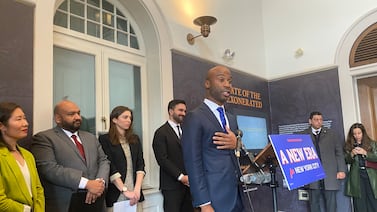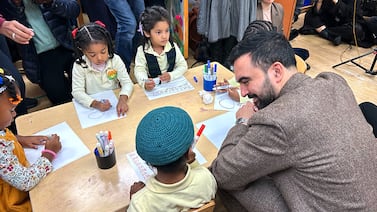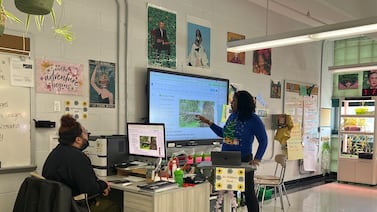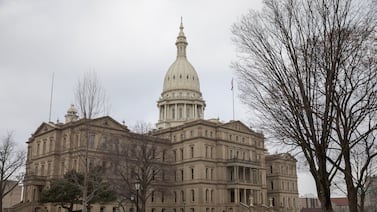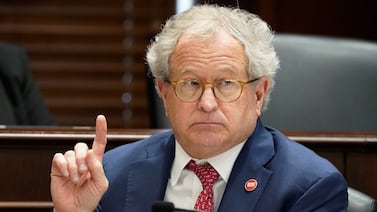Sign up for Chalkbeat’s free weekly newsletter to keep up with how education is changing across the U.S.
Federal funding for homeless students has helped Metro Nashville Public Schools meet kids’ evolving needs for decades.
It has sent tutors to family shelters to help children with their school work. It has paid for transportation when families got priced out of their homes and suddenly had to move cross-county.
And it pays for liaisons like Catherine Knowles, who for 28 years has listened to what homeless families say they really need and tried to respond. That’s why the district has a hotel-friendly food pantry filled with items like shelf-stable milk, microwaveable mac and cheese cups, and just-add-water cereal bowls.
“We’re giving that recognition of: We really do see what you’re going through,” Knowles said, “and we then have the flexibility to be responsive to that because we have funding and we have dedicated resources.”
The Trump administration has proposed doing away with this dedicated funding. The president’s Education Department budget proposal for fiscal year 2026 consolidates money for homeless students and 17 other programs into a single, much smaller K-12 block grant.
States would get $2 billion, down from the roughly $6.5 billion the federal government spends now. Schools could keep spending that money on the students and activities envisioned in federal law, or on a range of other activities, such as “promoting patriotic education,” or improving instruction in math, reading, science, and history.
In the current federal budget, Congress allocated $129 million to support homeless students with McKinney-Vento funding, named for the 1987 federal law that guarantees homeless children certain educational rights. That’s a tiny fraction of the roughly $18 billion the federal government spends specifically on high-poverty schools. Liaisons like Knowles worry homeless students will fall down the priority list if schools no longer get funding specifically to serve them.
“There is such increasing need among students in public education, in general,” Knowles said. “Without McKinney-Vento dedicated funding specifically spelling out our responsibilities and the rights of students experiencing homelessness, I’m just afraid it could kind of all get lost in the shuffle.”
Why Congress set aside money for homeless students
The Education Department has said the block grant would give states and schools the ability to spend federal funds more in line with their needs, “without the unnecessary administrative burdens imposed under current law.”
Several Republican governors have said they’d welcome education block grants. And some states, such as Iowa, that are seeking more flexibility in how they spend their federal education dollars have said they would continue to meet the needs of unique student groups, including homeless students.
Right now, the federal government gives each state money for homeless students based on their share of Title I funds, which support students in poverty. Then the state awards the money to districts on a competitive basis, because the sum is too small to divide among all of them. Around 1 in 5 school districts nationally get McKinney-Vento funding, which means many districts are required to hire homeless liaisons and meet homeless students’ needs without dedicated funding.
But school liaisons and advocates for homeless youth are calling on Congress to maintain funding for students experiencing homelessness as a standalone program.
In the early days of the McKinney-Vento Homeless Assistance Act, Congress tasked states and schools with rewriting policies and collecting data about students experiencing homelessness. That work exposed gaps in support, and prompted Congress to set aside money specifically for these students in 1990.
“The dedicated funding was about responding to those barriers,” said Barbara Duffield, the executive director of the nonprofit SchoolHouse Connection. In addition to legal protections, “you also have to have somebody who goes out looking for you, makes sure you have a ride, actually makes sure you can get enrolled.”
Since then, McKinney-Vento funding has played an outsized role in under-resourced communities that lack shelters, and “where the school literally might be the source of services for these families,” Duffield said.
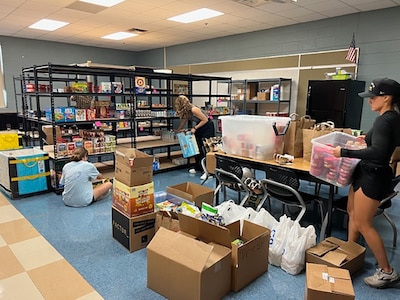
Researchers and school staff also point out that students experiencing homelessness have specific needs and greater academic challenges than even other children from low-income families. Homeless students have higher rates of absenteeism and are less likely to graduate from high school than their housed peers, even when compared with other kids living in poverty.
“Just imagine: If you go to a school that has high poverty, you’ve already been in poverty your whole life, and now you’re also unhoused,” said Jessica Smith, a social worker who is the McKinney-Vento coordinator for Kansas City, Kansas Public Schools. “It looks completely different than a student who just is low-income. Those babies need assistance, too, but our babies need just a little bit more of a focus.”
Smith, for example, uses part of her district’s McKinney-Vento funding to take high schoolers who live on their own without help from a parent to visit colleges and trade schools.
In Tennessee’s Robertson County Schools, McKinney-Vento funding provides students experiencing homelessness with clothing that meets the district’s dress code. And recently, it allowed the district to hire a translator to work specifically with Spanish-speaking homeless families, said Jennifer Dusky, a social worker who also serves as the district’s homeless liaison.
The rural community 30 miles north of Nashville is a major tobacco producer and attracts many migrant families. As that population has grown, the translator who handles requests from across the district couldn’t meet all the needs of homeless families and still get her other duties done, Dusky said.
“It was a need, for sure, to have a dedicated translator,” Dusky said. “Homelessness is not a comfortable thing for anyone to talk about, it’s very vulnerable and very scary. And then, of course, you add in the fact that you’re in a new country, you don’t speak the language. There’s all these fears and they’re very hesitant to talk with us. I totally get that.”
When the district hired a Spanish-speaking translator who had experienced homelessness herself, she helped identify, and provide support to, more homeless children.
“You can almost see the comfort just come over their face whenever they see her and talk to her,” Dusky said.
But when the district got half as much McKinney-Vento funding from the state this year as it has in years past, Dusky got a preview of the tough trade-offs schools nationwide would face if standalone funding went away. Her district had to decide if it could afford to keep the translator and the person who maintains McKinney-Vento records. For at least the next year, the district will dip into its own pocket to do so, but Dusky isn’t sure how long that will last.
“What can our program realistically withstand?” she said. “What can our community support?”
Congress will decide if block grant proposal advances
It is unclear whether Congress will approve the block grant proposal for homeless students and other programs.
The Senate Appropriations committee rejected the block grant in the bipartisan education budget bill they approved Thursday, and kept McKinney-Vento funding at $129 million a year. The House Appropriations committee won’t consider the education portion of the president’s budget until it returns from recess in September.
Some worry that Congress could repeal all or part of the law that authorizes McKinney-Vento funding to make the block grant legal, potentially leaving homeless students with fewer protections. Just a handful of states guarantee homeless students the same main educational rights outlined in federal law; most do not have any spelled out in state law, according to a recent report by SchoolHouse Connection.
Smith in Kansas City, Kansas, worries what that could mean for her students, many of whom stay over the state line in Kansas City, Missouri, because there are no shelters in her community. When that happens, both districts share the cost of transporting the child to school, Smith said, but she’s not sure what would happen if Missouri and Kansas decided to spend their block grants differently.
“If we don’t have something that focuses on this particular population they’ll get overlooked — as they often do already,” Smith said.
Correction: This article has been updated to accurately describe how federal funding for homeless students is determined. It’s based on each state’s share of Title I funds, not on how many homeless students they identify.
Kalyn Belsha is a senior national education reporter based in Chicago. Contact her at kbelsha@chalkbeat.org.


